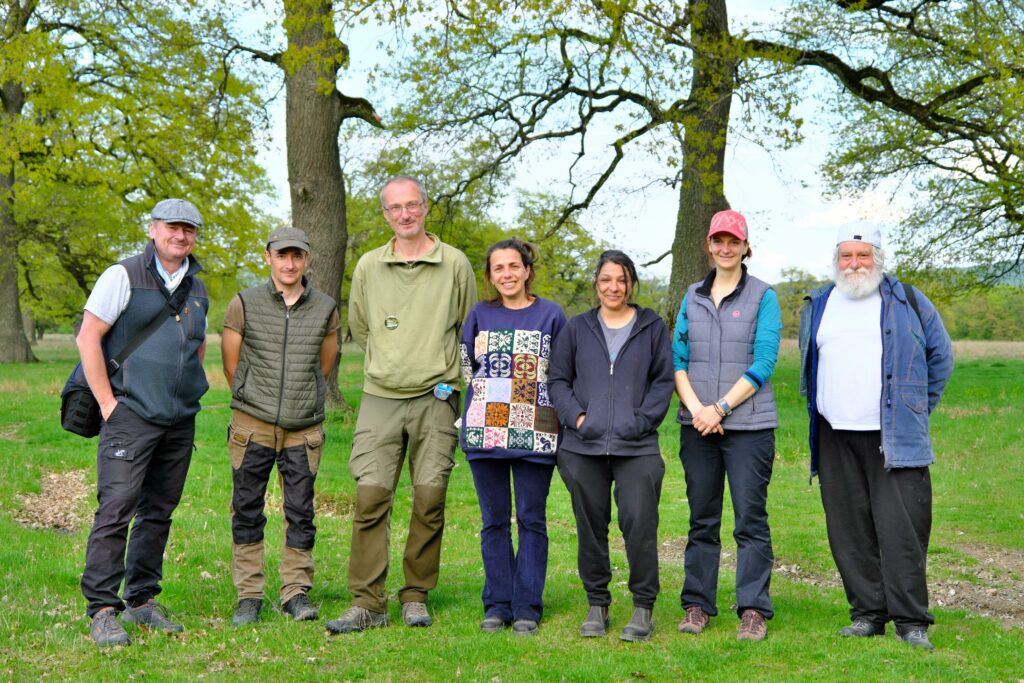On April 24-May 2, for 7 days, the Transylvanian wood-pastures project steering group, IfaS from Germany, made for the first time a visit to Romania to meet the Romanian partners from Babes-Bolyai University (BBU). The aim of the visit was to familiarize with the wood-pastures and to interact with those representants of the local communities who see social, cultural, economic and nature conservation opportunities in the wood-pastures and have a holistic view for their sustainability. The state of the wood-pastures will be analyzed on 3 levels in the following months: ecological, cultural and socio-economic. This would be achieved through fieldwork (wood-pasture assessment, social research), excursions to meet the users of these systems and talk with them, drone video recordings and photos. Here we provide a brief glimpse into our 7 day activities. Given that Transylvania is rich in biocultural regions, and we aim to visit each of these, we selected the Saxon historical region for this trip for three reasons: first, this region is the richest in unique ancient wood-pastures in Central and Eastern Europe. Second, this biocultural regions is well studies from ecological and socio-cultural perspectives through the work of our project member Tibor Hartel (BBU, Faculty of Environmental Sciences and Engineering). Third, the Romanian partne
rs of this project have over a decade long trusted relationship with the members of the local communities, through several formal and informal projects co-implemented.
On the first day the Breite and Apold pastures near Sighisoara, Mures county, were visited. Here, the once in good condition trees provided wood but also fixed the soil on the slope. Today they have extraordinary natural, cultural & historical value. Breite is exceptional because of its legacy value not only with respect to the ancient wood-pasture, but also plays a key role in the nature conservation activism in the post-communist Romania. In both Breite and Apold wood-pastures we enjoyed the culturally modified ancient trees – hornbeam coppices and pollards – which are unique legacies of the past land management and also have extraordinary biological and ecological values.
The 2nd day was spent on the Mociar pasture in Gurghiu where several small local producers carry out their activity and the residents and semi-residents, who have holiday homes there, live in a close relationship with that pasture. The Hungarian name of Mociar is Mocsár, that is swampy, wet area. Indeed, the whole area is scattered with wetlands with rich amphibian communities.
In the following days we visited the wood-pastures of Rupea, Corund, Saschiz and Viscri-a small village with an extraordinary cultural and touristic value where people still practice the old grazing techniques, and where the Cattle Breeders’ Association (Viscri) is active. This day was exceptional because we experienced the mechanized argiculture in ancient wood-pasture (with dead trees, scrubs removed, the soil nivelated and without anthills – Rupea) but also the traditional wood-pasture management (Viscri). Interestingly, both management outcomes (intensification and nature friendly farming) are possible under the CAP rules, and this highlights the importance of local aspirations, visions, intentions, knowledge and power relations through which CAP rules maniphests and shapes management and wood-pasture condition.
On the penultimate day, we had the opportunity to meet a young and enthusiastic person from the Mercheașa who has already implemented several recreational activities for the local community and tourists. On the territory of this pasture you can experience a biking-tour with electric bikes, observe buffalos or the oldest oak tree from Transylvania, also called “The Old Carpathian” or participate in concerts and traditional celebrations in the pasture. The unique feature of Mercheașa is that in its eastern side there is one of the largest known ancient wood-pastures in Romania.
Our last day was in the wood-pasture of Saschiz, where we meet the project leader of „Muzeu SilviCultural” and had the opportunity to attend one of their educational activities with the local children on the Saschiz pasture.
This was a fantastic experience, thanks to the enthusiastic people who exhibited genuine engagement and innovation related to the maintenance of the multifunctional character of the ancient wood-pasture systems. These wood-pastures are part of the uniquess of Romania and if they will persist to the future generations, it will be because of the current initiatives which inspire others through good will and innovation.
We sincerely thank all participants for their informative contributions and stories, the local communities for their cooperation, and our Romanian hosts for their extraordinary hospitality and tasty regional specialties.






















